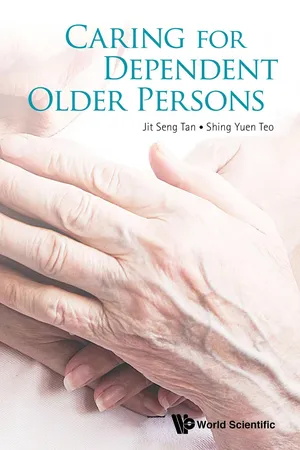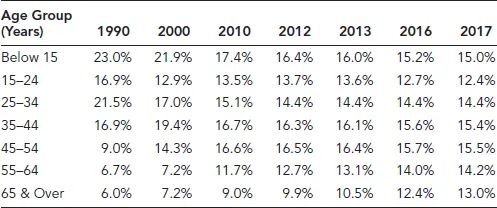
- 104 pages
- English
- ePUB (mobile friendly)
- Available on iOS & Android
Caring for Dependent Older Persons
About This Book
Caring for Dependent Older Persons details the knowledge that a caregiver should have when caring for an older person who is dependent on his/her care.
The main part of this book is a step-by-step guide on all the necessary skills needed when helping an older person with his/her Activities of Daily Living, monitoring of the person's health and the overall care of the older person. This book provides holistic knowledge by explaining how age and disease affect an older person.
It also covers the potential stress that a caregiver may endure while taking care of an older person. It is a valuable reference guide for a caregiver during the journey of caregiving. This book is the first of its kind to provide caregivers with comprehensive information on taking care of a dependent older person, especially in the Singapore context. The step-by-step explanation can be a reference guide for caregivers before or after their caregiver training.
The financial help section gathers information on all the schemes available in Singapore that can help with the care of a dependent older person. A comprehensive list of financial help available in Singapore is also detailed in this section.
This book is co-written by Dr. Tan who has many years of experience running a medical homecare service. He has shared the pertinent information that a caregiver should be equipped with.
Contents:
- Introduction:
-
- Aging Population Trend
- Activities of Daily Living (ADLs)
- Training Modules for the Caregiver of a Dependent Older Person:
- Basic Care of a Dependent Older Person
- Health Index Monitoring at Home
- Food, Medication and Supplement Administration
- Equipment Management
- Home Environment Assessment, Rehabilitation and Infection Control
- Basic Wound Management and Dressing
- Recognition of Emergent Conditions
- Effects of Aging and Common Diseases:
-
- Effects of Aging
- Common Diseases Envountered by Caregivers
- Caregiver Stress Management:
-
- How to Identify Caregiver Stress?
- Different Caregiver Stress in Different Clinical Situations
- Financial Support and Useful Information for Eldercare:
-
- Financial Subsidies
- Lasting Power of Attorney (LPA)
- Appointment of a Deputy for an Older Person Lacking Mental Capacity
- Useful Information for Eldercare
- Current and Future Technologies Supporting Eldercare:
-
- Types and Uses of Technologies
- Examples of Current New Technologies and Future Technologies
Readership: Caregivers, Caregiver training organisations.
Frequently asked questions
Information
1 Introduction
AGING POPULATION TREND


ACTIVITIES OF DAILY LIVING (ADLS)
The Basic ADLs are:
2 Training Modules for the Caregiver of a Dependent Older Person
MODULE 1: BASIC CARE OF A DEPENDENT OLDER PERSON
Part 1: Washing/Bathing
Performance Skill #1: Proper Hand Washing Techniques
Performance Skill #2: Partial Bed Bath/Full Shower or Tub Bath
Partial Bed Bath
Full Shower or Tub Bath
Performance Skill #3: Performing Shaving and Nail Care
Performing Shaving
Nail Care
Table of contents
- Cover
- Halftitle
- Title
- Copyright
- Preface
- Acknowledgements
- Contents
- 1. Introduction
- 2. Training Modules for the Caregiver of a Dependent Older Person
- 3. Effects of Aging and Common Diseases
- 4. Caregiver Stress Management
- 5. Financial Support and Useful Information for Eldercare
- 6. Current and Future Technologies Supporting Eldercare
- Index